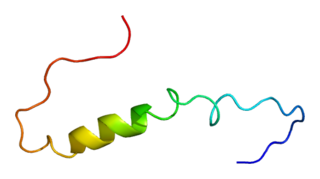
Voltage-dependent L-type calcium channel subunit beta-4 is a protein that in humans is encoded by the CACNB4 gene.

Sodium channel subunit beta-3 is a protein that in humans is encoded by the SCN3B gene. Two alternatively spliced variants, encoding the same protein, have been identified.

Voltage-gated potassium channel subunit beta-1 is a protein that in humans is encoded by the KCNAB1 gene.

Calcium-activated potassium channel subunit beta-2 is a protein that in humans is encoded by the KCNMB2 gene.

Potassium voltage-gated channel, Shaw-related subfamily, member 4 (KCNC4), also known as Kv3.4, is a human gene.

Sodium channel subunit beta-2 is a protein that in humans is encoded by the SCN2B gene.

Potassium channel subfamily K member 5 is a protein that in humans is encoded by the KCNK5 gene.

Potassium inwardly-rectifying channel, subfamily J, member 14 (KCNJ14), also known as Kir2.4, is a human gene.

Potassium intermediate/small conductance calcium-activated channel, subfamily N, member 1 , also known as KCNN1 is a human gene encoding the KCa2.1 protein.

Calcium-activated potassium channel subunit beta-4 is a protein that in humans is encoded by the KCNMB4 gene.

Voltage-dependent calcium channel gamma-4 subunit is a protein that in humans is encoded by the CACNG4 gene.

Potassium voltage-gated channel subfamily G member 1 is a protein that in humans is encoded by the KCNG1 gene.

Voltage-dependent calcium channel gamma-1 subunit is a protein that in humans is encoded by the CACNG1 gene.

Potassium voltage-gated channel subfamily A member 6 also known as Kv1.6 is a protein that in humans is encoded by the KCNA6 gene. The protein encoded by this gene is a voltage-gated potassium channel subunit.

Potassium voltage-gated channel subfamily F member 1 is a protein that in humans is encoded by the KCNF1 gene. The protein encoded by this gene is a voltage-gated potassium channel subunit.

Potassium voltage-gated channel subfamily G member 3 is a protein that in humans is encoded by the KCNG3 gene. The protein encoded by this gene is a voltage-gated potassium channel subunit.

Potassium voltage-gated channel subfamily G member 4 is a protein that in humans is encoded by the KCNG4 gene. The protein encoded by this gene is a voltage-gated potassium channel subunit.

Potassium voltage-gated channel subfamily S member 1 is a protein that in humans is encoded by the KCNS1 gene. The protein encoded by this gene is a voltage-gated potassium channel subunit.

Potassium voltage-gated channel subfamily S member 2 is a protein that in humans is encoded by the KCNS2 gene. The protein encoded by this gene is a voltage-gated potassium channel subunit.

Potassium voltage-gated channel subfamily H member 6 is a protein that in humans is encoded by the KCNH6 gene. The protein encoded by this gene is a voltage-gated potassium channel subunit.

















